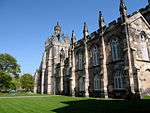University of Aberdeen
The University of Aberdeen (Scots: University o Aiberdeen; abbreviated as Aberd. in post-nominals) is a public research university in Aberdeen, Scotland. It is an ancient university founded in 1495 when William Elphinstone, Bishop of Aberdeen and Chancellor of Scotland, petitioned Pope Alexander VI on behalf of James IV, King of Scots to establish King's College,[4] making it Scotland's third-oldest university and the fifth-oldest in the English-speaking world.
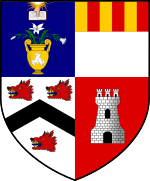 Coat of arms of the University of Aberdeen | |
| Latin: Universitas Aberdonensis | |
| Motto | Latin: Initium sapientiae timor domini |
|---|---|
Motto in English | The fear of the Lord is the beginning of wisdom |
| Type | Public research university Ancient university |
| Established | 1495[1] |
| Endowment | £48.6 million (as of 31 July 2018)[2] |
| Budget | £219.5 million (2017–18)[2] |
| Chancellor | The Duchess of Rothesay |
| Rector | Maggie Chapman |
| Principal | George Boyne |
Academic staff | 1,086 (2018)[2] |
Administrative staff | 1,489 (2018)[2] |
| Students | 14,775 (2018/19)[3] |
| Undergraduates | 10,185 (2018/19)[3] |
| Postgraduates | 4,590 (2018/19)[3] |
| Location | Aberdeen, Scotland, UK |
| Campus | College town |
| Colours | Burgundy and white (university colours) |
| Affiliations | |
| Mascot | Angus the Bull |
| Website | www |
The university comprises three colleges - King's College, Marischal College, and Christ's College - that are now mainly ceremonial. The university as it is currently constituted was formed in 1860 by a merger between King's College and Marischal College, a second university founded in 1593 as a Protestant alternative to the former. The university's iconic buildings act as symbols of wider Aberdeen, particularly Marischal College in the city centre and the crown steeple of King's College in Old Aberdeen. There are two campuses; the predominantly utilised King's College campus dominates the section of the city known as Old Aberdeen, which is approximately two miles north of the city centre. Although the original site of the university's foundation, most academic buildings apart from the King's College Chapel and Quadrangle were constructed in the 20th century during a period of significant expansion. The university's Foresterhill campus is next to Aberdeen Royal Infirmary and houses the School of Medicine and Dentistry as well as the School of Medical Sciences. Together these buildings form one of Europe's largest health campuses.[5] The annual income of the institution for 2017–18 was £219.5 million of which £56.1 million was from research grants and contracts, with an expenditure of £226.8 million.[2]
Aberdeen has 14,775 students from undergraduate to doctoral level (as of 2018/19), including many international students. An abundant range of disciplines are taught at the university, with 650 undergraduate degree programmes offered in the 2012–13 academic year. Aberdeen has educated a wide range of notable alumni, and the university played key roles in the Scottish Reformation, Scottish Enlightenment, and the Scottish Renaissance. Five Nobel laureates have since been associated with the university: two in Chemistry, one in Physiology or Medicine, one in Physics, and one in Peace.[6]
History
King's and Marischal Colleges
.jpg)
There appears to have existed in Old Aberdeen, from a very early period, a Studium Generate, or University, attached to the Episcopal Chapter of the See of Aberdeen. It is said to have been founded in 1157 by Edward, Bishop of Aberdeen, and although, according to Boece, it still existed at the period when King's College was founded, it is probable that it had in some way ceased to answer the purposes which it must have been designed to serve, since King James IV., in his letter to Pope Alexander VI., requesting him to found a University in Old Aberdeen, mentions as the chief motive for the undertaking, the profound ignorance of the inhabitants of the north of Scotland, and the great deficiency of properly educated men to fill the clerical office in that part of his kingdom.[7]
The first university in Aberdeen, King's College, formally The University and King's College of Aberdeen (Collegium Regium Abredonense), was founded on 10 February 1494 by William Elphinstone, Bishop of Aberdeen, Chancellor of Scotland, and a graduate of the University of Glasgow drafting a request on behalf of King James IV to Pope Alexander VI resulting in a Papal Bull being issued.[4] It seems that James was keen to ensure that Scotland had as many universities as England at the time, and it was to possess all the privileges enjoyed by those of Paris and Bologna, two of the most highly favoured in Europe. The university, modelled on that of the University of Paris and intended principally as a law school, soon became the most famous and popular of the Scots seats of learning, largely due to the prestige of Elphinstone and his friend, Hector Boece, the first principal appointed in 1500. Its aim was to train doctors, teachers and clergy who would serve the communities of northern Scotland, as well as lawyers and administrators for the Scottish Crown. It was a collegiate foundation with 36 full-time staff and students and walls protecting it from the outside world. In 1497 the College established the first chair of medicine in the English-speaking world.
The first book (there was no printing press in Scotland at the time) to be printed in Edinburgh and in Scotland was the Aberdeen Breviary, which was written by both Elphinstone and Boece in 1509.[8]
Following the Scottish Reformation in 1560, King's College was purged of its Roman Catholic staff but in other respects was largely resistant to change. George Keith, the fifth Earl Marischal, was a moderniser within the college and supportive of the reforming ideas of Peter Ramus and Andrew Melville.[9] In April 1593 he founded a second university in the 'New Town', Marischal College. It is also possible the founding of another college in nearby Fraserburgh by Sir Alexander Fraser, a business rival of Keith, was instrumental in its creation. Aberdeen was highly unusual at this time for having two universities in one city: as 20th-century University prospectuses observed, Aberdeen had the same number as existed in England at the time (the University of Oxford and University of Cambridge).
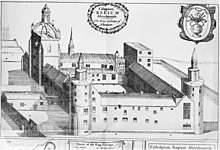
Initially, Marischal College offered the Principal of King's College a role in selecting its academics, but this was refused - the first blow in a developing rivalry. Marischal College, in the commercial heart of the city (rather than the ancient but much smaller collegiate enclave of Old Aberdeen), was quite different in nature and outlook. For example, it was more integrated into the life of the city, such as allowing students to live outwith the college. The two rival colleges often clashed, sometimes in court, but also in brawls between students on the streets of Aberdeen. Duncan Liddell endowed the first chair in mathematics at Marischal College in 1613, but the first professor wasn't appointed until 1626.
As the institutions put aside their differences, a process of attempted (but unsuccessful) mergers began in the 17th century. During this time, both colleges made notable intellectual contributions to the Scottish Enlightenment. Both colleges supported the Jacobite rebellion and following the defeat of the 1715 rising were largely purged by the authorities of their academics and officials.
King Charles' University (1641-61) and the merger of the two Colleges (1860)
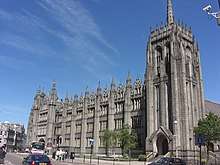
The nearest the two colleges had come to full union was as the "Caroline University of Aberdeen", a merger initiated by Charles I of Scotland in 1641, which united the two colleges for twenty years. Following the civil conflicts of the Wars of the Three Kingdoms, a more complete unification was attempted following the ratification of Parliament by Oliver Cromwell during the interregnum in 1654. This united university survived until the Restoration whereby all laws made during this period were rescinded by Charles II and the two colleges reverted to independent status.[10] Charles I is still recognised as one of the university's founders, due to his part in creating the Caroline University and his benevolence towards King's College.[11]
The Aberdeen Philosophical Society (known locally as the Wise Club) was created by Thomas Reid, George Campbell, David Skene, John Gregory, John Stewart, and Robert Traill, and held its first meeting in the Old Red Lion Inn on 12 January 1758. From its inception, the society was an intimate, private body whose members were drawn exclusively from the learned professions, and this feature differentiated it from the more open and socially inclusive societies like the Glasgow Literary Society or the Select Society of Edinburgh. Over 133 papers were given and discussed at the meeting, and many of these formed the basis of books subsequently published. The society was eventually disbanded in March 1773. The society and its individual members played a key role in the Scottish Enlightenment, and it was the most important forum for the promotion of enlightened thought and values in Aberdeen.[12] The Philosophical Society was revived in 1840, with the object of receiving and debating original scientific, literary and philosophical papers from its members; however, the decision was taken on 13 September 1939 to discontinue its meetings, chiefly in view of the difficulties posed by the war, although it does not appear to have been ever formally wound up.[13]

The Free Church of Scotland founded Christ's College in Aberdeen in 1843 for the training of ministers. An extravagant Gothic building, with a commanding oriel window and tower, was erected for the college at the western end of Union Street in 1850. Linked to the college was a museum and library (containing 17,000 volumes).[14] Following the Church reunion of 1929, Christ's College became a Church of Scotland college and was also integrated into the University of Aberdeen; henceforth, the university has been composed of three colleges. The college building is no longer used by either the Church or the University, and the College is contained completely within the buildings of King's College, maintaining its own Divinity library. The University hosted its first meeting of the British Science Association in 1859. Having no suitable meeting place to host the meeting, the town raised the money themselves by personal subscription and built the Music Hall.[15] It was capable of holding about 2,500 people and so successful was the meeting that associate membership, necessary to gain access to the proceedings, had to be capped. Prominent among the local organisers were Professors James Clerk Maxwell (Natural Philosophy) and James Nicol (Geology) of Marischal College. Prince Albert, the Prince Consort, took on the role of President for the year. The young Maxwell himself, still only 28, spoke on three different subjects, one being a presentation of his newly discovered law of molecular velocities in a gas. The ‘Maxwell distribution law’, as it is now known, is the law of physics with the strongest Aberdeen connection. In addition, Sir Charles Lyell, President of the Geological Section of the British Academy, and a champion Charles Darwin's work, made one of the first announcements that Darwin had undertaken a body of work on evolution and was about to release his findings. The organisers felt that they might be risking something in holding the meeting much further north than they had done before but in the event the Aberdeen meeting was the most well attended the BA had ever had.[16]
Further unsuccessful suggestions for union were brought about throughout the 18th and early 19th centuries.[10] William Ogilvie, known as the Rebel Professor, proposed a paper on the union and reform of the two colleges in 1787, but the proposals were rejected by seven (known as the 'seven wise Masters') out of ten professors at King's.[17] The evolving examination system and university research now required much higher academic standards from the students. The two colleges in Aberdeen merged on 15 September 1860 in accordance with the Universities (Scotland) Act 1858, which also created a new medical school at Marischal College. The 1858 Act of Parliament stated the "united University shall take rank among the Universities of Scotland as from the date of erection of King's College and University." The university is thus Scotland's third oldest and the United Kingdom's fifth oldest University.
The transference of the Arts classes from Marischal to King's College required the extension of King's at the cost of £20,000. This included the rebuilding of two sides of the quadrangle for the class-rooms (1862) and the erection of the library (1870), which for many years had occupied the nave of the chapel.[18]
In 1873, university students voted against university degrees being open to women.[19] However, all faculties were open to women in 1892, and in 1894 the first 20 matriculated females began their studies at the university. Four women graduated in arts by 1898, and by the following year, women made up a quarter of the faculty.[20]
The modern university
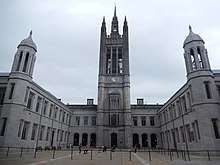
The closing of the quadrangle of Marischal College was completed during the university's quatercentenary in 1906, which was officially opened by Edward VII and Alexandra, and which saw some of the most extravagant celebrations and expressions of civic pride ever demonstrated in Aberdeen.[21] Four days of festivities took place across the City, which included church services, banquets, torchlight processions, and fireworks displays. In all, the cost of the four days of festivities was the modern equivalent of £1.34 million. The ceremony saw the granting of honorary degrees to over a hundred public and academic figures from across the academic world.[22] In an extravagant display of luxury, Lord Strathcona, the then Chancellor of the University, spent £8518 in entertaining around 2500 invited guests in a tent specially designed for the occasion.[23] After having received an honorary degree (LLD) in 1905, Thomas Hardy celebrated Aberdeen as ‘a University which can claim in my opinion to an exceptional degree that breadth of view & openness of mind that all Universities profess to cultivate, but many stifle’. Hardy wrote a poem for a special number of the student publication, Alma Mater, in celebration of the quatercentenary of the university.[24]
‘I looked and thought, "All is too gray and cold
To wake my place-enthusiasms of old!"
Till a voice passed: "Behind that granite mien
Lurks the imposing beauty of a Queen."
I looked anew; and saw the radiant form
Of Her who soothes in stress, who steers in storm,
On the grave influence of whose eyes sublime
Men count for the stability of the time’
In the 20th century, the university expanded greatly, particularly at King's College. New buildings were constructed on the land around King's College throughout the 20th century. Initially, these were built to match the ancient buildings (e.g. the New King's lecture rooms and Elphinstone Hall), but later ones from the 1960s onward were constructed in brutalist style. Meanwhile, the Foresterhill campus began to train medical students in the 1930s next to Aberdeen Royal Infirmary.

During the mid-20th century departments which had been at Marischal College moved into one of these new buildings (most at King's College) and by the late 20th-century Marischal College had been abandoned by all but the Anatomy Department, a graduation hall and the Marischal Museum (Marischal College has now been restored as the headquarters of Aberdeen City Council, which is leasing a portion of the complex from the university). Following extensive fundraising, a £57 million new university library (the Sir Duncan Rice Library) opened in autumn 2011 at the King's College campus to replace the outgrown Queen Mother Library[25] and was officially opened by the Queen in September 2012.[26] Today, most students spend most of their time in modern buildings which provide up-to-date facilities for teaching, research and other activities such as dining. However, the old buildings at King's College are still in use as lecture and tutorial rooms and accommodation for various academic departments.
In February 2020, the Scottish Funding Council (SFC) found that in approving a financial settlement agreement with the former Principal Professor Sir Ian Diamond, the university failed to make best use of public funds or exercise good governance. As a result of the investigation, the university was ordered to repay £119,000 of grant finance to the SFC and undertake an externally-facilitated examination of its governance and culture.[27]
Buildings and campuses
The original buildings of both colleges which united to form the university are much admired architectural features of Aberdeen. The main campus is now at King's College, where the original buildings are still in use in addition to many newer buildings of largely modernist style. A second campus at Foresterhill houses the School of Medicine, Medical Science & Nutrition.[28] In addition, there are smaller facilities at other sites such as the Royal Cornhill Hospital to the west of the city centre, and the Rowett Institute in Bucksburn.
King's College
The King's College campus covers an area of some 35 hectares around the ancient King's College buildings and the High Street. It hosts around two-thirds of the university's built estate and most student facilities, and lies 2 miles north of Aberdeen city centre.[28] The university does not own all the buildings on the "campus" which also include private houses, shops and businesses (although many of these rely heavily on custom from the university community) and it is best thought of as a district of the city dominated by the university. It can be reached from the city centre by bus routes 1, 2, 13, 19 and 20 operated by First Aberdeen and from northern Aberdeenshire or the bus station at Union Square by various routes operated by Stagecoach Bluebird.
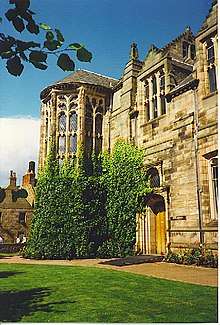
The historic King's College buildings form a quadrangle with an interior court, two sides of which have been rebuilt and expanded with a library wing in the 19th century. The Crown Tower and the Chapel, the oldest parts, date from around 1500. The original foundation contained the Chapel, the Great Hall and living accommodation, with its own kitchen and brewery, a well in the quadrangle, and a college garden to provide herbs and vegetables. The Grammar School was just outside the walls, in front of the College. The Crown Tower is surmounted by a structure about 40 ft (12 m) high, consisting of a six-sided lantern and Imperial crown, both sculptured, and resting on the intersections of two arched ornamental slips rising from the four corners of the top of the tower. This crown, also known as the "Crown of Kings", frequently acts as a symbol of the university. The choir of the chapel contains original oak-canopied stalls, miserere seats, and lofty open screens in the French flamboyant style. They were preserved by the college's Principal during the Reformation, who fought off local barons who had attacked the nearby St Machar's Cathedral. The Cromwell Tower, created between 1658-1662 opposite the Crown Tower, was originally built as residential accommodation, but an observatory was built on top in 1826.[29] The library wing was converted into an exhibition and conference venue in the 1990s and today also houses the university's Business School.
The first of the modern age of construction in the King's campus began with the construction in 1913 of the New Building (now known as "New King's"), largely in a similar architectural style to the old buildings. A large manse located on the lawn opposite King's College was removed before the First World War.[30] New King's groups to form a yet larger quadrangle-like green for the campus also bordered by the High Street, King's and Elphinstone Hall, a traditional 1930 replacement for the Great Hall. The Elphinstone Hall was subsequently used as a dining facility but is now used for graduations, examinations, fairs, and other large university events.
However, most students and staff spend relatively little time in these historic buildings, with a large number of modern ones housing most facilities and academic departments. Most date from the second half of the 20th century. Some of these echo the existing architecture of Old Aberdeen, such as the Fraser Noble Building with its distinctive concrete crown designed to resemble the one adorning King's College. Other buildings were constructed of stone in the 1950s (e.g. the Taylor Building and Meston Building). A number of other buildings are designed in the brutalist style, such as the Arts Lecture Theatre and adjoining William Guild Building, opened in 1969 to house the School of Psychology. Also on the site is the Cruickshank Botanic Garden which was presented to the university in 1899 and is open to the public.
The Powis Gateway forms the east gate and archway from College Bounds, Old Aberdeen. These oriental style towers with minarets have provoked much interest over the years. At one time there was a portrait of John Leslie dressed in Turkish costume, on the walls of Powis House, but there is no obvious connection between the estate and the Middle East. The gateway is also adorned with panels bearing the coats of arms of the Lairds of Powis. The Estate of Powis was owned by the Frasers - their crest is shown on the towers - until the marriage of an heiress to a Leslie. Powis House was built by Hugh Leslie. The house was the home of John Leslie, Professor of Greek at Kings College. It was subsequently owned by the Burnett Family. In 1936, J.G. Burnett sold most of the estate to Aberdeen Town Council who built a housing estate in the area comprising over 300 residences.[31]
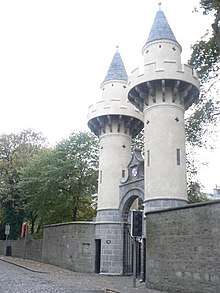
The most recent building on campus is the Sir Duncan Rice Library, completed in 2011 and designed by Danish architects Schmidt Hammer Lassen. It was officially opened by Queen Elizabeth II in September 2012 and named after Duncan Rice, a previous Principal of the university.[26] This seven-storey tower, clad in zebra-like jagged stripes of white and clear glass, replaced the smaller Queen Mother Library as the university's main library and can be seen prominently from the entire campus and much of the city. It is open to the public and outstanding views of the city and coastline are available from the upper floors. In addition to expanded facilities it also houses public exhibition space and the university's historic collections, comprising more than a quarter of a million ancient and priceless books and manuscripts collected over five centuries since the university's foundations.[32] Other libraries are in the Taylor Building on the same campus (for law books and materials) and at Foresterhill (for medicine and medical sciences). The university's library service (i.e. including all libraries) holds over one million books.
Marischal College
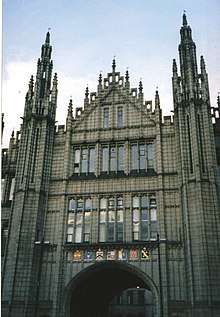
Marischal College is a neo-Gothic building, having been rebuilt in 1836–41, and greatly extended several years later. Formerly an open three-sided court, the college now forms a quadrangle as additions to the buildings were opened by King Edward VII in 1906 and form the current facade from Broad Street. The building is widely considered to be one of the best examples of neo-Gothic architecture in Great Britain; the architect, Alexander Marshall Mackenzie was a native of Aberdeen as well as an alumnus of the university. The Mitchell Tower at the rear is named for the benefactor (Dr Charles Mitchell) who paid for the graduation hall. The opening of this tower in 1895 was part of celebrations of the 400th anniversary of the university.
Until 1996, Marischal College housed the Departments of Molecular & Cell Biology and Biomedical Sciences, which had been there for many decades. From 1996, the departments moved to Kings College campus and Foresterhill campus. Teaching no longer takes place at Marischal College, with many of the departments formerly based there having moved to King's College some decades previously. While graduations and other events (e.g. concerts) took place in the cathedral-like Mitchell Hall in the north wing, for many years much of the building (including the frontage to the street) was derelict. A restoration project was completed in 2011 and restored the building and its ornamentation. The Broad Street frontage is now on long-term lease to Aberdeen City Council and forms the administrative headquarters for the city, replacing the ageing St. Nicholas House across the street.[33] The project provided modernized public facilities and office accommodation for the Council as well as cosmetic rejuvenation, and involved the demolition and reconstruction of internal spaces while retaining and restoring the outer walls and windows. The university controls the north wing of the building containing the Marischal Museum and Mitchell Hall which was used in the past for graduation and other academic ceremonies.[28] Graduations take place at Elphinstone Hall at King's College.
Other campuses
Doha, Qatar
A new state of the art campus has been established in Doha, Qatar since May 2017. They have expanded their School of Business to Qatar. The courses currently offered are Accounting & finance and Business Management. The first batch started on 10 September 2017. The university requirements are the same as those in the Kings College Campus which are A*ABB to AAAB. These students will be the first ones to graduate at a campus abroad. The current Principal is Brian Buckley and Dean is Russell Williams.

Foresterhill
The Foresterhill site contains the university's School of Medicine, Medical Science & Nutrition, Medical Library and associated modern buildings for teaching and research. The School includes the Rowett Institute of Nutrition, the Institute of Medical Sciences, Institute of Applied Health Sciences, Institute of Dentistry, and Institute of Education for Medical & Dental Sciences. It is at Foresterhill, in Aberdeen's West End. It became part of the university's holdings in 1938 following the move of the Medical School and forms part of a modern teaching hospital complex alongside the Aberdeen Royal Infirmary. The 41 hectare site is split between the university (owning around a third) and NHS Grampian.[28]
Hilton
A small campus at Hilton became part of the university estate following a merger in 2001 between the university and the Aberdeen campus of the Northern College of Education, and temporarily became home to the university's Faculty of Education. It was less than a mile southwest of King's College campus.[28] Following the renovation of the MacRobert Building at King's College to house the School of Education (completed in 2005), the Hilton campus was closed and sold to developers.[34] The campus was demolished and the land is now occupied by a residential development called "The Campus".
Organisation and administration
Governance
In common with the other ancient universities in Scotland, the university's structure of governance is largely regulated by the Universities (Scotland) Acts of 1858. This gives the university a tripartite constitution comprising the General Council of senior academics and graduates, the University Court responsible for finances and administration, and the Academic Senate (Senatus Academicus) - the university's supreme academic body.

There are correspondingly three main officers of the university. It is nominally headed by the Chancellor, a largely ceremonial position traditionally held by the Bishop of Aberdeen but divorced from the see as a result of the Scottish Reformation and holders are now elected for life by the General Council. There is also a rector of the university, who chairs the University Court and is elected by the students for a three-year term to represent their interests. There are also four Assessors, ten Masters, including the Principal and Vice Principal, and the factor or Procurator.
The administrative head and chief executive of the university is its principal and vice chancellor. The principal acts as chair of the Senatus Academicus, and his status as vice chancellor enables him to perform the functions reserved to the chancellor in the latter's absence, such as the awarding of degrees.
Chancellor
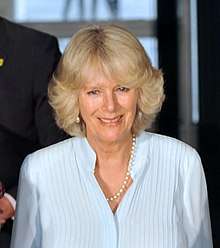
The chancellor is the nominal head of the university. The chancellor since 2013 is Camilla, Duchess of Rothesay.[35] She is the first female chancellor of the university. The Chancellor, or, if necessary, his or her deputy, confers degrees on graduates and chairs the university's General Council.
Lord Rector
The rector of the university has been—since 1860—elected by the students to serve a three-year term of office; before that, the office was appointed. The Rector's duties are to chair meetings of the University Court and to represent student views on that body. In November 2014, a new rector was elected by the student body of the university, Maggie Chapman, co-convenor of the Scottish Green Party.[36] Other notable Aberdeen rectors have included Winston Churchill, Andrew Carnegie, H. H. Asquith, and Clarissa Dickson Wright, who was Aberdeen's first female rector.[37]
Principal and Vice-Chancellor
The principal and vice-chancellor of the university is Professor George Boyne. He joined the university on 1 August 2018 and was officially installed in his role on 16 January 2019.[38]
The University Court
This body was created by the Commissioners during the merger of King's and Marischal in 1870. It was part of a series of reforms introduced to rectify the method of government, with the Court acting as a court of appeal from the Senatus.[39] The Court originally consisted of six members; the Rector, representing the students, the Principal, and one Assessor each to the Chancellor, the Rector, the General Council and the Senatus. However, today the Court consists of many more members.[40] The Court's principal role is to oversee the management of the revenue, property and other resources of the University.
Senatus Academicus
The Academic Senate (Latin Senatus Academicus) is the supreme academic body for the university. Its members include all the professors of the university, certain senior readers, a number of senior lecturers and lecturers and elected student senate representatives. It is responsible for authorising degree programmes and issuing all degrees to graduates, and for managing student discipline. The President of the Senate is the University Principal.
Colleges
The university is composed of three colleges: Christ's College, King's College and Marischal College. The purpose of the colleges at Aberdeen is mainly ceremonial, as students are housed in separate residential halls or private accommodations. Originally, Medicine and Law were taught at Marischal and Arts and Divinity at King's College; however, since 2009 all of the teaching is now done at King's College and Foresterhill.
Schools and Institutes
The University is divided into 12 schools which are organised within a broad range of disciplines, with the larger schools sub-divided into three teaching colleges.
Multi-disciplinary institutes and research centres allow the University's experts to collaborate on pioneering research projects.
|
|
|
|
|
|
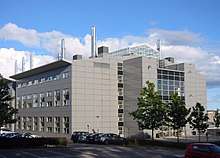 Institute of Medical Sciences, Aberdeen
Institute of Medical Sciences, Aberdeen Chemistry Department
Chemistry Department Cruickshank Building
Cruickshank Building Edward Wright Building
Edward Wright Building Fraser Noble Building
Fraser Noble Building Geography Department
Geography Department History Department
History Department Faculty of Education
Faculty of Education Zoology Building
Zoology Building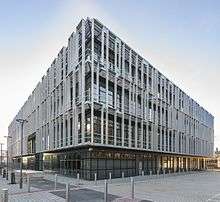 The Rowett Institute
The Rowett Institute King's Pavilion
King's Pavilion A mosaic of the University of Aberdeen coat of arms on the floor of King's College
A mosaic of the University of Aberdeen coat of arms on the floor of King's College
Symbols of the university
The university's coat of arms is an integral part of the current logo, which along with the colours burgundy and white, is used extensively on campus signage, printed materials, and online.
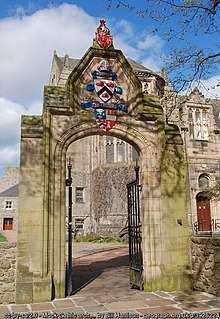
Coat of arms
The university's coat of arms incorporates those of the founders and locations of the two colleges it is derived from. In the top left quadrant are the arms of the burgh of Old Aberdeen, with the addition of a symbol of knowledge being handed down from above. Top right are those of George Keith, the fifth Earl Marischal. Bottom left are those of Bishop William Elphinstone.[41] The bottom right quarter is a simplified version of the three castles which represent the city of Aberdeen[42] (this symbol of the city also appears prominently on the arms of The Robert Gordon University).
Motto
The motto of the University of Aberdeen is Initium Sapientiae Timor Domini, which translates from Latin as "The beginning of wisdom is fear of the Lord". It is a quote from the Old Testament of the Bible, Psalm 111, verse 10. It also appears in the Book of Proverbs (9:10). The motto can be seen at the archway beside New King's on the High Street at the King's College campus, as well as other campus locations and in formal settings such as on graduation certificates.
Tartan
A university tartan was created in 1992 as part of the celebrations for the 500th anniversary of the university which took place in 1995. The tartan was designed by the Weavers Incorporation of Aberdeen and Harry Lindley and incorporates colours from the university's coat of arms.[43]
Academic dress
_(imp-cswc-GB-237-CSWC47-LS5-1-004).jpg)
Academic dress has been worn in the University of Aberdeen since mediaeval times.[44] Aberdeen shared with the other ancient universities the wearing of scarlet gowns (toga rubra) and a trencher for undergraduates, but by the middle of the twentieth century its use amongst the students had faded.[45] Bursars formerly wore a black gown, and were made to perform menial services about college. Female students wore a trencher with scarlet tassels, while male students wore black tassels.[46]
Academic dress is usually worn only at formal occasions, such as at graduation, Founder's Day, or academic processions which take place for ceremonial reasons. For undergraduate degrees (e.g. MA, BSc, LLB etc.), a long black gown is worn with a hood of black silk and lined with silk in a colour which varies depending on discipline. For example, the lining is white silk for all Master of Arts degrees, green silk for Bachelor of Science in pure sciences, and crimson silk for MBChB. A black mortarboard is also worn. For master's degrees (e.g. MSc, MLitt etc.) a long black gown is worn, with a white silk hood lined in a colour that varies by discipline. For PhD, the doctor's scarlet robe is worn with black facings and sleeve lining, along with a black "John Knox" cap. For other doctoral degrees (e.g. EdD, LLD etc.), the scarlet robe has facings and sleeve linings in a different colour.
Academics
Semesters
The academic year at Aberdeen was originally based upon the Scottish Term and Quarter Days, beginning with Martinmas (October - November), Candlemas (January - March), and ending with Whitsunday (April - June). However, today the academic term is divided into two semesters, the First Half-Session and the Second-Half Session, beginning in September and ending in May. Written examinations are sat in November and April and May, and graduation is celebrated either in November or at the end of June.[47]
Rankings and reputation
| National rankings | |
|---|---|
| Complete (2021)[48] | 26 |
| Guardian (2020)[49] | 34 |
| Times / Sunday Times (2020)[50] | 27 |
| Global rankings | |
| ARWU (2019)[51] | 201-300 |
| CWTS Leiden (2019)[52] | 107 |
| QS (2020)[53] | 194 |
| THE (2020)[54] | 168 |
Aberdeen is consistently ranked among the top 200 universities in the world[55] and is ranked within the top 30 universities in the United Kingdom.[56][57] In the 2019 Times Higher Education University Impact Rankings, Aberdeen was ranked 31st in the world for impact on society.[58] Aberdeen was also named the 2019 Scottish University of the Year by The Times and Sunday Times Good University Guide.[59] Over 75 per cent of the University's research was classified as 'world leading' or 'internationally excellent' in the 2014 Research Excellence Framework.[60]
Its highest internationally ranked subject is Divinity and Religious Studies, which is ranked at joint 25th in the world and 7th in the UK.[61] It also has an excellent reputation for medical research and many of its subjects are ranked in top 10 in the UK, including Accounting & Finance (ranked 4th in the UK, Complete 2021), Civil Engineering (10th in the UK, Complete 2021), Dentistry (9th in the UK, Complete 2020), Education (9th in the UK, Complete 2021), General Engineering (7th in the UK, Complete 2020), Law (6th in the UK, Complete 2021), Medicine (4th in the UK, Complete 2021), Linguistics (5th in the UK, Complete 2021) and Sports Science (2nd in the UK, Complete 2021).[62] Aberdeen also has great reputation for economics with leading graduate prospect in the country. Economics was ranked 11th in the UK by Times Subject Rankings[63] and 12th in the UK by Complete University Guide 2019.[64] Aberdeen was ranked 9th for the average entry tariff by the Complete University Guide 2021[65] and 11th in the UK for the average entry tariff by Guardian 2020 rankings,[66]
The university has one of the smallest percentages of students from lower-class backgrounds, being ranked fifth from bottom for class equality.[67][68] The university participates in widening access schemes such as the Children's University, REACH Scotland, Access Aberdeen, and ASPIRENorth, in order to promote a more widespread uptake of those traditionally under-represented at university.[69]
Lecture series
The Gifford Lectures, established in 1887 by Adam Gifford, began at the university (along with the other ancient universities in Scotland) with E.B Tylor's lecture on the Natural History of Religion between 1889–1991. Since then, over 30 Gifford Lectures have been given at the university, with some distinguished figures including Hannah Arendt, Alfred North Whitehead, Paul Tillich, Michael Polanyi, and Jaroslav Pelikan.[20]
A public lecture series was held in 2011 to commemorate the 400th anniversary of the publication of the King's James Bible.[70] The university is also host to the annual Andrew Carnegie Lecture Series which began in 2014, with the first lecture given by Matthew Barzun.[71]
The Elphinstone Institute hosts its own monthly lecture series, which began in 2016, in the MacRobert Building, with lectures usually given on local or Scottish topics. The School of Engineering also hosts the RV Jones Distinguished Lecture Series which provides invited lectures from distinguished speakers in areas of engineering related to research within the School of Engineering.[72]
Libraries and Museums
The library at university has undergone many trials and tribulations: it was first located in the nave of King's College Chapel and then moved to a new site in the College in 1870.[73] The current library contains one of the most extensive university library collections in the United Kingdom, with over a million volumes and a quarter of a million ancient and priceless books and manuscripts, including the Hortus sanitatis.[74] The library at Aberdeen was given the right of legal deposit under the Statute of Anne (1710) but this was rescinded in 1837, and as a result has a rare collection of pre-Victorian novels.[75] The core of the original library at King's College was formed from Elphinstone's books that he left to the university. The books were originally housed in a room in the south east tower (now the round tower). They were then moved to a building on the south side of Kings College Chapel, and in 1773 to the west end of the Chapel. They were located in 1870 to a new building as illustrated. This library was extended in 1885, with galleries being installed in 1912, reading desks in 1932 and a mezzanine floor in 1964.[76] The Queen Mother Library had been the university's main library since 1965, and the original library in King's College was replaced with the King's College Conference Centre in 1991.
The Sir Duncan Rice Library was officially opened on 24 September 2012 by Her Majesty Queen Elizabeth accompanied by the Duke of Edinburgh, replacing the Queen Mother Library. It was designed by the Danish architectural firm Schmidt Hammer Lassen at the cost of £57 million. The building sits on a base of Scottish stone. The ground floor is double-height with seven floors above. The building is clad in zebra-like jagged stripes of white and clear glass. In the interior void spaces are located centrally. Contrasting with the geometric exterior, the central atrium formed by the void spaces has an organic form, shifting in location across the levels. It has won numerous awards for its architecture.[77]
The university also has the Taylor Library and European Documentation Centre (law with official UK and EU publications), which is located in Old Aberdeen, and the Medical Library on the Foresterhill Campus covers the Medicine and Medical Sciences disciplines.[78] Christ's College also possesses its own Divinity library.
The university maintains several museums and galleries, open free to the public.[79] The University's collections are internationally renowned and are recognised as of national significance by the Scottish Government. Originating in the eighteenth century, they now have over 300,000 items across a wide range of Human Culture, Medicine and Health, and Natural History. The Zoology Museum is officially classified as a Recognised Collection of national significance to Scotland and features displays from protozoa to the great whales, including taxidermy, skeletal material, study skins, fluid-preserved specimens and models.
Student life
As of 2018/19 the university had 14,775 students, of which 4,590 were postgraduates.[3] In 2009/10 students represented 120 different countries with about 46% men, 54% women. Of all of undergraduates, 19% were mature students (i.e. aged 25 years or more). The university has more than 550 different undergraduate degree programmes and more than 120 postgraduate taught programmes.[6]
Students' Association
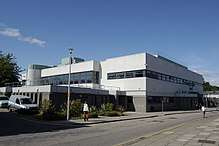
The student body is represented by a students' association known as Aberdeen University Students' Association (AUSA). Additionally, the elected Rector of the University of Aberdeen serves along with the rector's assessor and AUSA president as a students' representatives on the University Court.
AUSA does not operate a traditional students' union, instead operating out of a university building, Johnston, helping to support students and provide events and studying space. A large students' union formerly occupied an impressive granite building on the corner of Gallowgate and Upperkirkgate in the city centre, opposite Marischal College, but it closed in 2003. A second, smaller union opened at nearby Littlejohn Street a couple of years later, but by 2010 it too had closed.[80]
The organisation has been involved in the creation of "The Hub", a university-owned dining and social centre created by an extensive renovation of the former Central Refectory at the King's College campus. It provides facilities for the whole university community (students and staff) and opened in 2006. A more traditional social space, the Butchart Student Centre, opened in 2009. It acts as the HQ of the Students' Association and provides a wide range of student facilities, but due to city council licensing regulations there is no bar. Facilities at the Butchart Centre include a large cafe, second-hand bookstore, facilities for student societies and offices. The Butchart Centre was converted from what had been the campus sports centre before the opening of the Aberdeen Sports Village nearby. AUSA operates out of the Johnston Building.
Student societies and organisations
There are over a hundred clubs and societies formally affiliated with the students' association.[81] The students' association is responsible for sport at the university, which is managed by the Aberdeen University Sports Union, an AUSA committee. All registered students are eligible to join any of these clubs or societies.
The university's oldest student organisation is the Aberdeen University Debater, founded by JF Maclennan in 1848 as the King's College Debating Society.[82][83][84] In 1871, a Literary Society was started by WM Ramsay, and four years later a Choral Society came to life.[85] In 1884, the society also took the first steps towards the introduction of a Students' Representative Council under support from Alexander Bain, the then Rector. The creation of the Union in 1895 provided a new debating chamber in Marischal College and the society's first permanent home. The chamber beneath Mitchell Hall in Marischal College is Scotland's oldest purpose-built debating chamber.
The first successful university newspaper, Alma Mater, began under the auspices of the University of Aberdeen Debating Society in 1883. The Alma Mater was replaced by The Gaudie, which has been in circulation since 1934, and is currently free-of-charge. The Gaudie is recognised as one of the oldest student newspapers in Scotland and the United Kingdom. It currently consists of 32 pages split into the sections News, Features, Science and Environment, Opine, International, Puzzles, Satire, Life and Style, Arts, Gaming and Tech, and Sports.
The Aberdeen Student Show is a musical and theatrical show, usually with a strong comedy element, staged every year since 1921. Its purpose is to raise money for charity, as part of the Aberdeen Students' Charities Campaign (“ASCC”). From the start it has involved a number of young writers, performers and musicians who have gone on to greater renown in the fields of theatre, media and the arts.
Each year a student-led torcher parade is held. First held in 1889, it is the largest of its kind in Europe.[86] Student groups and societies build floats and parade in fancy dress through the city centre to raise money for local charities. Traditionally spectators donate money in the form of coppers, a colloquial term for 1p and 2p coins.
The Aberdeen Future Fund is an alumni fund run by the Development Trust. Since founding in 1998, Aberdeen Future Fund has raised over £2.5 million of unrestricted funds. Past projects have included a book fund for the Heavy Demand section in the library, providing "Safe Campus" leaflets, contributing to the student hardship fund, providing training mannequins for Clinical Skills, the organ for King's College Chapel, and funding for intramural sports.[87]
University accommodation
Halls of residence are managed by the university. Two large concentrations of University accommodation are provided on the campus in Old Aberdeen and one mile north at the Hillhead Village.
Campus accommodation in the heart of Old Aberdeen consists of self-catered King's Hall and Elphinstone Rd Halls.
The Hillhead Village is located beside Seaton Park, a 20-minute walk or a 5-minute bus ride to King's campus, and comprises a large number of catered and self-catered accommodation across 9 different properties. At the heart of the Hillhead Village is the Head Space. In addition, other student accommodation in the city is owned and operated by private providers such as Unite Group.
Following their first year, the majority of students live in private accommodation off-campus or in privately owned halls of residence. In recent years, rents and availability of accommodation has seen more second and third year students returning to university halls.
The university has a "First-Year Accommodation Guarantee". In 2014–15, the university ran out of rooms and had to resort to temporary accommodation.[88] The university continues to monitor accommodation costs and where possible offers discretionary support to students, to improve access to higher education.[89]
Halls of residence include:
- Adam Smith House
- Elphinstone Road Flats
- Fyfe House
- Grant Court
- Hector Boece Court
- Keith House
- Kings Hall
- New Carnegie Court
- North Court
- South House
- Wavell House
Sports clubs and the Sports Union
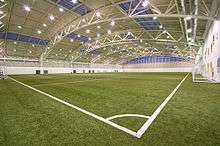
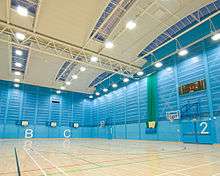
The students' association is responsible for sport at the university, which is managed by the Aberdeen University Sports Union, an AUSA committee. Established in 1889, it's affiliated to the BUCS and SSS and encompasses over fifty sports clubs.[90] There are large playing fields at the back of King's College and also Aberdeen Sports Village, a partnership between the University of Aberdeen, Aberdeen City Council and sportscotland. The venue includes a nine-court indoor hall, full-sized synthetic football pitch, synthetic cricket wicket, fitness suite, squash courts and a sports performance lab among other facilities. The development on the site of the former Chris Anderson Stadium, opened on 24 August 2009. An aquatics centre featuring a 10 lane 50 m pool and diving complex opened in 2014.
A notable club is the Aberdeen University Football Club, which was formed in 1872, and currently competes in the SJFA North First Division. The Aberdeen University Rugby Football Club, founded in 1871, has a long history of producing both Scottish and British Lions players.
The annual boat race between University of Aberdeen and Robert Gordon University has been competed for since 1995. The University of Aberdeen has lost only four times, in 2006, 2009, 2012 and 2013.
Aberdeen Sports Village served as one of the official pre-games training venues of the Cameroon Olympic Team prior to the London 2012 Olympic Games.
Music
There are a large number of ensembles at the University of Aberdeen. Some are directed by academic staff, while others are run by students both in and out of the department and include; Balinese Gamelan, Baroque Ensemble, Big Band, Cantores ad Portam, Chapel Choir, Choral Society, Concert Band, Elphinstone Fiddlers, Flute Choir, New Music Ensemble, Steel Pans, String Orchestra, Symphony Orchestra, Viol Consort.
Student media
There are a number of student media organisations at the University of Aberdeen. These include The Gaudie[91] (student newspaper), Granite City TV and Aberdeen Student Radio (ASR).[92]
Traditions
Sponsio Academica
The Sponsio Academica is the oath, originally in Latin, taken by students matriculating into the four ancient Scottish universities (Edinburgh, St. Andrews, Aberdeen and Glasgow). This tradition now has been digitised at Aberdeen and is agreed to as part of an online matriculation process. Originally, new students matriculated in Mitchell Hall where the Chancellor would give a welcoming address.
Since 1888 the School of Medicine has used a form of the Sponsio Academica for graduating students to affirm in response to the discontinuation of the oath hitherto taken by students in all faculties:[93]
"I solemnly declare that as a Graduate of Medicine of the University of Aberdeen, I will exercise my profession to the best of my knowledge and ability, for the good of all persons whose health may be placed in my care, and for the public weal; that I will hold in due regard the honourable traditions and obligations of the Medical Profession, and will do nothing inconsistent therewith; and that I will be loyal to the University and endeavour to promote its welfare and maintain its reputation.'[94]
Founders' Day
Usually held annually in February, on Founders’ Day, the university community pays tribute to its historic origins as an ancient University and in particular, the role played by William Elphinstone and other benefactors in the establishment of the University. The ceremony begins with an academic procession through the university and concludes with a service in King's College Chapel. Talks are given by university lecturers and invited guests. A candle is lit in the chapel to give thanks to Elphinstone and the other patron fathers.
Installing of the Rector
The Rector, an ancient post dating back to the foundation of the University in 1495, is the students’ representative, particularly in welfare matters, and sits on the University Court.
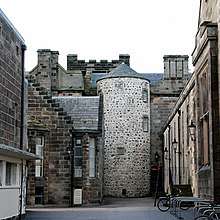
Tradition dictates that the University of Aberdeen's new rector must ride through Old Aberdeen aloft a bull carried at shoulder height by students of the university. The ceremony includes a colourful academic procession representing civic, student and academic life in Aberdeen. University staff and students, along with representatives from the City and Aberdeenshire Councils, Incorporated Trades, MSPs, and alumni, attend the ceremony which is followed by a reception in the King's Conference Centre.[95]
The reception culminates with the new Rector being carried by the student mascot, Angus the Bull, from King's College to the St Machar Bar in the High Street of Old Aberdeen, where tradition also dictates that he buy a round of drinks for his student supporters.
Bajan
Bajan, a medieval term (literally 'yellow beak' – bec jaune), describing trainees in the pre-student year, was traditionally applied to Aberdeen University first year undergraduates. Female undergraduates were referred to as "bajanellas".[96] Second year students were called 'Semis', and these usually played jokes upon or clashed with bajans. Semis would usually tear first year's gowns.[97]
These terms were based on the four years of the degree:
- B first year (bajan)
- S second year (semi)
- T third year (tertian)
- M fourth year (magistrand)[98]
Notable alumni and academics
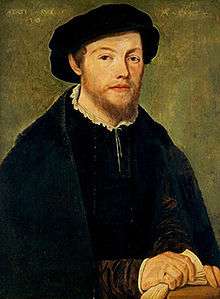 George Wishart, father of the Scottish Reformation.
George Wishart, father of the Scottish Reformation.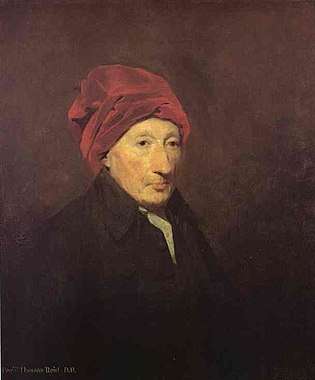 Thomas Reid, founder of the Scottish School of Common Sense.
Thomas Reid, founder of the Scottish School of Common Sense.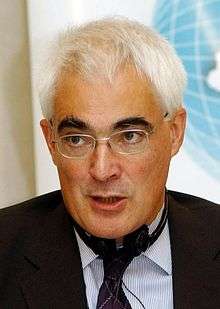 Alastair Darling, Chancellor of the Exchequer.
Alastair Darling, Chancellor of the Exchequer.
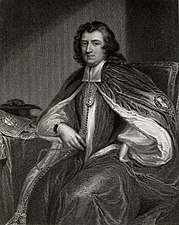
 Patrick Manson, founder of the field of tropical medicine, the London School of Tropical Medicine, Dairy Farm, and the University of Hong Kong.
Patrick Manson, founder of the field of tropical medicine, the London School of Tropical Medicine, Dairy Farm, and the University of Hong Kong.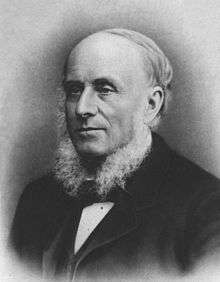 Alexander Bain, philosopher, psychologist, and founder of the first psychology journal, Mind.
Alexander Bain, philosopher, psychologist, and founder of the first psychology journal, Mind..jpg) Robert Brown, botanist and discoverer of Brownian motion.
Robert Brown, botanist and discoverer of Brownian motion.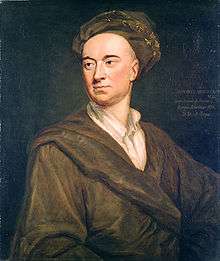 John Arbuthnot, scientist, mathematician, court physician to Queen Anne, author, and co-founder of the Scriblerus Club.
John Arbuthnot, scientist, mathematician, court physician to Queen Anne, author, and co-founder of the Scriblerus Club. James Mackintosh, philosopher, historian, and Whig politician.
James Mackintosh, philosopher, historian, and Whig politician.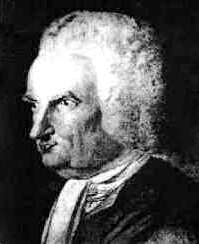 James Burnett, Lord Monboddo, jurist and pioneer anthropologist who anticipated principles of Darwinian evolution.
James Burnett, Lord Monboddo, jurist and pioneer anthropologist who anticipated principles of Darwinian evolution. James Gregory, discoverer of the infinite series and designer of the first practical reflecting telescope, the Gregorian telescope.
James Gregory, discoverer of the infinite series and designer of the first practical reflecting telescope, the Gregorian telescope. James Blair, founder of The College of William and Mary.
James Blair, founder of The College of William and Mary.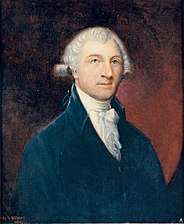 William Thornton, physician, inventor, painter, and architect of the United States Capitol.
William Thornton, physician, inventor, painter, and architect of the United States Capitol.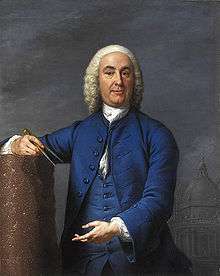 James Gibbs, architect.
James Gibbs, architect.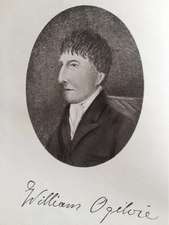 William Ogilvie, 'rebel professor', reformer, and a leading proto-Georgist thinker.
William Ogilvie, 'rebel professor', reformer, and a leading proto-Georgist thinker.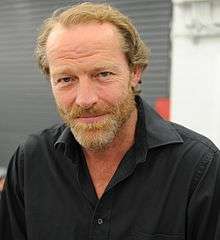 Iain Glen, actor.
Iain Glen, actor. James Macpherson, writer, poet, politician, and 'translator' of the Ossian cycle of epic poems.
James Macpherson, writer, poet, politician, and 'translator' of the Ossian cycle of epic poems.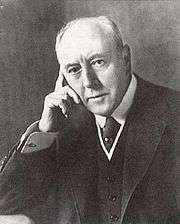 Sir Thomas Sutherland, banker, politician, and founder of the Hong Kong Bank and Shanghai Banking Corporation (HSBC).
Sir Thomas Sutherland, banker, politician, and founder of the Hong Kong Bank and Shanghai Banking Corporation (HSBC)._-_)_was_a_Scottish_inventor_who_built_the_first_known_electric_locomotive_in_1837.jpg) Robert Davidson, inventor of the electric locomotive.
Robert Davidson, inventor of the electric locomotive.
Many notable figures in a variety of fields, both academic and otherwise, have taught, studied, and worked at the University of Aberdeen. See https://www.abdn.ac.uk/alumni/blog/fellows-of-the-royal-society-from-the-university/
Aberdeen has produced leading figures in the UK, Scottish, and foreign governments, including the Lord Chancellor George Gordon,[99] former Counsellor of State William Barclay, the former Secretary of State for Scotland, Alistair Carmichael, former Secretary of State for Scotland, George Mackenzie, former Chancellor of the Exchequer, Alistair Darling, the former Paymaster General, Tessa Jowell, the former Deputy Leader of the Scottish National Party, Angus Robertson, the former Leader of the Scottish Labour Party, Kezia Dugdale, the former Deputy Leader of the Scottish Conservative Party, Murdo Fraser, the former Leader of the Scottish Liberal Democrats, Nicol Stephen, the former leader of the Scottish Green Party, Robin Harper, John Rose, former Finance Minister and Solicitor General of Canada, Sylvester Douglas, former Chief Secretary for Ireland, and Cosmo Gordon, politician and co-founder of the Royal Society of Edinburgh. Aberdeen has produced numerous politicians, Lords, MPs, MSPs, and cabinet members.[100] The former Chief Constable of Police Scotland and current Deputy Commissioner of the Metropolitan Police, Stephen House, and the current Chief Constable of Police Scotland, Iain Livingstone. Additionally, businessmen such as Stephen Carter, founding CEO of Ofcom and Minister for Communications, Technology and Broadcasting under Gordon Brown, David Reid, former chairman of Tesco, Sir Thomas Sutherland, the founder of Hongkong and Shanghai Banking Corporation (HSBC), and Will Whitehorn, former president of Virgin Galactic, and Donald Cruickshank, former chairman of the London Stock Exchange.
Prominent alumni in law include former Lord President Duncan Forbes, Lord Advocate George Mackenzie, Lady Dorrian, the current Lord Justice Clerk in the Court of Session, William Grant, former Master of the Rolls, Frank Mulholland, former Lord Advocate and Solicitor General, Andrew Skene, former Solicitor General and co-founder of the Bannatyne Club, Priyantha Jayawardena, current Judge of the Supreme Court of Sri Lanka, Bertha Wilson, the first female Pusine Justice of the Supreme Court of Canada, Cosmo Innes, former Principal Clerk of the Session and historian, Bruce Allan Clark, prominent Canadian lawyer and First Nations activist, James Stephen, abolitionist lawyer who drafted the Slave Trade Act 1807 for William Wilberforce, and Alexander Asher, Dean of the Faculty of Advocates. Aberdeen has also produced numerous Senators of the College of Justice: Alastair Campbell, Alexander Seton, Francis Grant, James Ferguson, Morag Wise, and Lord Woolman.
Aberdeen is well known in historical, philosophical and theological circles, and it was an important centre in the Scottish Reformation and the Scottish Enlightenment. George Wishart,[101] reformer and father of the Scottish Reformation, teacher of John Knox, and early Protestant martyr, John Erskine, a religious reformer who ranks only after John Knox in importance of those who made the Scottish Reformation happen,[102] John Lesley, Roman Catholic Bishop of Ross, historian, and counsellor to Mary, Queen of Scots, and Florentus Volusensus, a Renaissance humanist. The six Aberdeen Doctors, under the tutelage of Patrick Forbes, who opposed the National Covenant of 1638 and whose opposition was important in instigating the First Bishops' War. Thomas Reid, the founder of the Scottish School of Common Sense, Thomas Blackwell, John Gregory, James Beattie, James Macpherson, George Campbell, and Alexander Gerard, were all significant figures in the Scottish Enlightenment. Aberdeen has produced three Historiographer Royal: John Hill Burton, David Masson, and Robert Rait. Gilbert Burnet, Bishop of Salisbury, philosopher, adviser to William and Mary and noted historian of the Scottish Reformation and English Civil War, James Mackintosh, Whig politician, philosopher, and historian of the French Revolution and the Glorious Revolution, Joseph Robertson and John Stuart, historians and founders of the Spalding Club, and James Burnett, a pioneer anthropologist and founder of modern comparative historical linguistics and a precursive figure in the modern theory of evolution. William Smith, the first Provost of the University of Pennsylvania, James Blair, founder of The College of William and Mary, and William Small, co-founder of the Lunar Society and teacher of Thomas Jefferson. Other academics who were ungraduates at Aberdeen include William Geddes, Sue Black, President of the Royal Anthropological Institute, Michael Lynch, George Croom Robertson, Robert Adamson, William Robinson Clark, Andrew Ross, Colin Campbell, Oliver D. Crisp, James Legge, and Arthur Thomson. James Gregory, Duncan Liddel, Henry Farquharson, George Chrystal, and Leetsch C. Hsu, were noted mathematicians.
Prominent alumni of the medical faculty include Patrick Manson, who first proposed malaria was transmitted by mosquito, and was the founder of the tropical medicine field, the London School of Hygiene and Tropical Medicine, and the Dairy Farm in 1886. Robert Brown, botanist and discoverer of Brownian motion, William Watson Cheyne, pioneer in the use of antiseptic surgical methods under Joseph Lister, Kai Ho, politician, co-founder of the University of Hong Kong and teacher of Sun Yat-sen, Peter Shepherd, who introduced the concept of teaching first aid to civilians, James Cantlie, pioneer in the use of first aid, William Wilson Jameson, Chief Medical Officer (1942–44) and an important figure in the development of the National Health Service, Graeme Catto, former President of the General Medical Council, Alexander Ogston, discoverer of Staphylococcus aureus, Alexander Stuart, Alexander Mowat, pioneer of paediatric hepatology, Robert Daniel Lawrence, founder of the British Diabetic Association, Joseph Adams, founder of medical genetics, and Arthur Keith, discoverer of the sinoatrial node. The first full-body MRI scanner was also invented in Aberdeen.[103]
Alumni in literature and journalism include Alexander Ross, Chaplain-in-Ordinary to Charles I and the first to translate the Quran into English, Thomas Urqhuart, the first to translate Rabelais into English, writer and poet Tobias Smollett, Ali Smith, the author of the Booker Prize nominated novel Hotel World and the Whitbread Award winning novel The Accidental, George Coleman the Younger, James Fordyce, Rosemary Ashton, Quain Professor of English Language and Literature at UCL, Simon Farquhar, Adam Roberts, and Archibald Forbes. George Chalmers, historian, antiquarian, occasional economist, and writer and serial biographer who courted controversy when paid by the Pitt ministry to publish a hostile biography on Thomas Paine, read for an MA at King's. George MacDonald, a pioneering figure in the field of fantasy literature and a mentor of fellow writer Lewis Carroll, read for an MA between 1840 and 1845. James Murdoch, journalist and linguist, wrote the first comprehensive history of Japan in the English language. Nan Shepherd, the Modernist writer and poet, and Eric Linklater, poet, author, and military historian, who both played key roles in the Scottish Renaissance.
Aberdeen has produced radio, music and television personalities including Iain Glen, Nicky Campbell, Laura Main, James Fleet, Emun Elliott, James Naughtie, Sandy Gall, Iain Cuthbertson, Momus, Glen Oglaza, Rebstar, Rhod Sharp, and Derek Rae were also students.
Those known in architectural circles include William Thornton, the designer of the United States Capitol, Charles Mitchell who worked with John Dobson and commissioned the elegant art nouveau church of St George's Jesmond from Thomas Ralph Spence; and Alexander Marshall MacKenzie, who designed Australia House and the Waldorf Hilton.[104] Most significantly, James Gibbs, one of Britain's most influential architects and designer of the Radcliffe Camera at Oxford University and Senate House at Cambridge University, matriculated at the university.
Other figures include the inventor of percussion ignition, Alexander John Forsyth; Robert Gordon, the founder of Robert Gordon's College and Robert Gordon University; Brigadier General in the US Continental Army and close friend to George Washington, Hugh Mercer; the soldier and Frederick the Great's Generalfeldmarschall of the Prussian Royal Army James Keith; botanists C. H. Gimingham and M. R. Henderson; dermatologist Sir James Galloway; plant pathologist Lawrence Ogilvie; founding Classics professor of the University of Queensland John Lundie Michie; James Forbes, founder of the Scotch College; William MacGregor, Lieutenant-Governor of British New Guinea, Governor of Newfoundland and Governor of Queensland, and first Chancellor of the University of Queensland; ornithologist J. D. Macdonald; mountaineers Tom Patey and Andy Nisbet; Colonial Secretary of Hong Kong Frederick Stewart; sports broadcaster Tyrone Smith of STV News; sports broadcaster and international rugby player Ian Robertson; Taliban kidnap victim Linda Norgrove; comedian James Veitch; and the first Foreign Minister of the Republic of Kosovo, Skënder Hyseni in 1986.
Princess Royal Anne, Richard Dawkins, David Attenborough, Isaac Watts, Denis Law, J.K. Rowling, Thomas Hardy, Justin Welby, Andrew Carnegie, Edward Elgar, Henri Becquerel, and Tony Robinson, have been awarded honorary degrees from the university. Prizes awarded to alumni include the Lumsden and Sachs Fellowship.
Nobel Prize winners
- George Paget Thomson, Professor of Natural Philosophy (Physics) at Aberdeen from 1922 to 1930, together with the American physicist Clinton Davisson "for their (independent) experimental discovery of the diffraction of electrons by crystals". (1937)
- John James Rickard Macleod, jointly with Frederick Banting, for the research which led to the development of insulin as a treatment for diabetes. (1923)
- John Boyd Orr, 1st Baron Boyd-Orr, Director of the Rowett Institute and Professor of Agriculture from 1942 to 1945, in recognition of his contribution to the worldwide fight against hunger. (1949)
- Frederick Soddy, Professor of Chemistry at the University of Aberdeen from 1914 to 1919, for his work on radioactivity and isotopes (1921)
- Richard Laurence Millington Synge, biochemist with the Rowett Institute from 1948 to 1967, for the invention of partition chromatography, a technique used in the separation mixtures of similar chemicals that revolutionised analytical chemistry (1952)
Academics
Anthropology
Chemistry
- Frederick Soddy
- Frederik P Glasser
- Hal Taylor
- Anthony R. West
- Lesley Dent Glasser
Classics
Divinity
- Robin Barbour
- I Howard Marshall
- Ruth Edwards
- Iain Torrance
- Brian Brock
- Helen Bond
- Ian Bradley
- Tom Greggs
Economics
Engineering and Physical Sciences
- William MacGillivray
- James Nicol
- James Cossar Ewart
- Henry Alleyne Nicholson
- John Arthur Thomson
- James Ritchie
- Lancelot Thomas Hogben
- Alister Clavering Hardy
- Vero Copner Wynne-Edwards
- George Mackenzie Dunnet
- Paul Adrian Racey
English, Literature, and Poetry
- Herbert Grierson
- Andrew Rutherford
- George Rousseau
- Momus (musician), Nick Currie (Musician and writer)
Geology
History and History of Art
International Relations and Politics
Mathematics and Astronomy
Medicine and Physiology
Philosophy and Logic
Physics
- James Clerk Maxwell (1856-1860)
- John Mallard
- William A. Edelstein
- George Paget Thomson (1922-1930), Nobel Laureate, 1937[105]
- R. V. Jones (1946-1981)[105]
Psychology
See also
- 5677 Aberdonia, minor planet named after the University of Aberdeen
- List of medieval universities
- Ancient universities
References
- Bulloch, John Malcolm (1895). A History of the University of Aberdeen: 1495-1895. London: Hodder and Stoughton. p. 2. Retrieved 20 December 2012.
- "Annual Reports & Accounts 2018" (PDF). University of Aberdeen. Retrieved 19 January 2019.
- "Where do HE students study?". Higher Education Statistics Agency. Retrieved 1 March 2020.
- Bulloch, John Malcolm (1895). A History of the University of Aberdeen: 1495-1895. London: Hodder and Stoughton. pp. 18–19. Retrieved 20 December 2012.
- "Medicine - University of Aberdeen". Times Higher Education (THE). Retrieved 12 July 2018.
- "Fast Facts". University of Aberdeen. Retrieved 27 June 2014.
- Gregory, William (1845). The New Statistical Account of Scotland (1845).
- Bulloch, John Malcolm (1895). A history of the University of Aberdeen : 1495-1895. London: Hodder and Stoughton. p. 14.
- "This Noble College: Building on the European tradition". University of Aberdeen. Archived from the original on 8 May 2013. Retrieved 20 November 2010.
- "The New Statistical Account of Scotland - Account of the University and King's College of Aberdeen". Electricscotland.com. Retrieved 20 November 2010.
- "Founders' Day Service". Public Relations, University of Aberdeen, pubrel@abdn.ac.uk. 9 November 2004. Retrieved 20 November 2010.
- Wood, Paul (2006). "Aberdeen Philosophical Society". Oxford Dictionary of National Biography – via Oxford DNB.
- "Aberdeen Philosophical Society". The Doric Columns.
- "ALFORD PLACE, THE COLLEGE (FORMER CHRIST'S COLLEGE)". Historic Environment Scotland.
- Jones, RV (1973). "James Clerk Maxwell at Aberdeen". Notes and Records of the Royal Society of London. 28: 64. JSTOR 531113.
- "Aberdeen celebrates the 150th anniversary of Advancement of Science in the Granite City". The University of Aberdeen.
- MacDonald, DC (1997). Birthright in Land: Ogilvie. Palala Press.
- Bulloch, John (1895). A history of the University of Aberdeen. London : Hodder and Stoughton. p. 198.
- Rayner-Canham, Geoffrey (2020). Pioneering British Women Chemists: Their Lives And Contributions. World Scientific Europe. p. 235.
- "University of Aberdeen". Gifford Lectures.
- "The Quatercentenary celebrations, 1906". University of Aberdeen.
- "The Quatercentenary Celebrations of the University of Aberdeen" (PDF). Nature. 74 (1927): 565–567. 1906. Bibcode:1906Natur..74..565.. doi:10.1038/074565a0.
- "The Quatercentenary celebrations, 1906". University of Aberdeen.
- Ray, Martin. "Thomas Hardy in Aberdeen".
- "The Sir Duncan Rice Library". University of Aberdeen. Retrieved 12 July 2014.
- "Queen opens new library at Aberdeen University". BBC News. 24 September 2012. Retrieved 20 December 2012.
- Grove, Jack (18 February 2020). "Aberdeen told to repay £119K over ex-head's 'gardening leave'". Times Higher Education (THE). Retrieved 24 February 2020.
- "Estate Strategy 2002-2007". University Estates Office. Retrieved 13 August 2009.
- "History of the Cromwell Tower Observatory". Aberdeen University History.
- "Kings College Chapel and Manse". Silver City Vault.
- "Powis Gateway". The Silver City Vault.
- "Press Release: 'Flagship library project to match academic ambitions' leads next phase of University's infrastructure investment". University of Aberdeen. Retrieved 13 August 2009.
- "Marischal College | About | The University of Aberdeen". www.abdn.ac.uk. Retrieved 12 July 2018.
- "University seeks "TC" former students and staff for Hilton closing events". University of Aberdeen. 10 June 2005. Retrieved 20 November 2010.
- "Aberdeen University poised to install Duchess of Rothesay Camilla as new Chancellor". Daily Record. 10 June 2013. Retrieved 11 July 2014.
- "Maggie Chapman named as new University of Aberdeen rector". BBC News. 14 November 2014. Retrieved 14 November 2014.
- "Rectorial Election | Students' Infohub | The University of Aberdeen". www.abdn.ac.uk. Retrieved 25 October 2018.
- "Duchess of Cornwall congratulates new principal of University of Aberdeen". HeraldScotland. Retrieved 16 January 2019.
- Bulloch, James (1895). A history of the University of Aberdeen. London : Hodder and Stoughton. p. 198.
- "Court Members". University of Aberdeen.
- "University of Aberdeen - Coat of arms (crest) of University of Aberdeen". www.ngw.nl. Retrieved 8 August 2017.
- "University of Aberdeen - Armorial Tablet". The Heraldry Society of Scotland. Retrieved 18 August 2007.
- "Tartan Details - Aberdeen University (1992)". The Scottish Register of Tartans. Retrieved 20 December 2012.
- Cooper, J. C., 'Academical Dress in Late Medieval and Renaissance Scotland', Medieval Clothing and Textiles, 12 (2016), pp. 109-30. (Available here)
- Cooper, Jonathan C. (2010). "The Scarlet Gown: History and Development of Scottish Undergraduate Dress". Transactions of the Burgon Society. 10. doi:10.4148/2475-7799.1082.
- Rayner-Canham, Marlene (2020). Pioneering British Women Chemists: Their Lives And Contributions. World Scientific Europe. p. 235.
- "Academic Calendar". The University of Aberdeen.
- "University League Table 2021". The Complete University Guide. 1 June 2020.
- "University league tables 2020". The Guardian. 7 June 2019.
- "The Times and Sunday Times University Good University Guide 2020". Times Newspapers.
- "Academic Ranking of World Universities 2019". Shanghai Ranking Consultancy.
- "CWTS Leiden Ranking 2019 - PP top 10%". CWTS Leiden Ranking 2019.
- "QS World University Rankings 2020". Quacquarelli Symonds Ltd.
- "World University Rankings 2020". Times Higher Education.
- "University of Aberdeen Rankings". Quacquarelli Symonds. Retrieved 4 September 2015.
- "Top UK University League Tables and Rankings 2019". Retrieved 12 July 2018.
- "University Guide 2016 - The Times". nuk-tnl-editorial-prod-staticassets.s3.amazonaws.com. Retrieved 26 September 2018.
- "World Impact Rankings". Times Higher Education (THE). 2 April 2019. Retrieved 3 April 2019.
- "University of Aberdeen named Scottish University of the Year | News | The University of Aberdeen". www.abdn.ac.uk. Retrieved 21 September 2018.
- "Research Excellence Framework - University of Aberdeen results". Research Excellence Framework.
- "2020 QS World University Subject Rankings - Theology, Divinity & Religious Studies". nuk-tnl-deck-prod-static.s3-eu-west-1.amazonaws.com. Retrieved 30 May 2019.
- "Top UK University League Tables and Rankings 2020". www.thecompleteuniversityguide.co.uk. Retrieved 21 May 2019.
- "UK University Times Subject Ranking 2018 - Economics". www.ukuni.net. Retrieved 21 May 2019.
- "Economics - Top UK University Subject Tables and Rankings 2019". www.thecompleteuniversityguide.co.uk. Retrieved 21 May 2019.
- "2021 University Rankings". The Complete University Guide.
- "University league tables 2020". the Guardian. Retrieved 7 June 2019.
- Martin, Iain. "Benchmarking widening participation: how should we measure and report progress?" (PDF). HEPI.
- Busby, Eleanor. "Cambridge and Oxford among worst universities in UK for socio-economic equality, report reveals". The Independent.
- "Widening Access". University of Aberdeen.
- "Lecture series commemorates 400th anniversary of the King James Bible". University of Aberdeen.
- "Andrew Carnegie Lecture Series". Carnegie Corporation of New York.
- "RV Jones Distinguished Lecture Series". University of Aberdeen.
- Bulloch, John (1895). A history of the University of Aberdeen. London : Hodder and Stoughton. p. 196.
- "Sir Duncan Rice Library". University of Aberdeen.
- Attar, Karen (2016). Directory of Rare Book and Special Collections in the UK and Republic of Ireland. p. 450.
- "King's College Library, Old Aberdeen". Silver City Vault.
- "Sir Duncan Rice Library". The University of Aberdeen.
- "Our Libraries, Special Collections and Museums". The University of Aberdeen.
- "University Museums". The University of Aberdeen.
- "Gallowgate Students' Union". Canmore.
- "AUSA Societies Union". Aberdeen University Students' Association. Retrieved 11 July 2014.
- Anderson, R.D The Student Community at Aberdeen: 1860-1939 (AUP)
- McLaren, C.A. Aberdeen Students 1600-1860 (AUP)
- Hargreaves, J.D. and Forbes, Angela Aberdeen University 1945-1981: Regional Roles and National Needs (AUP)
- Bulloch, James (1895). A history of the University of Aberdeen. London : Hodder and Stoughton. p. 202.
- "125th anniversary of Aberdeen Torcher Parade". University of Aberdeen. Retrieved 4 November 2015.
- "Giving to Aberdeen". University of Aberdeen. Retrieved 3 September 2011.
- "Rooms shortage forces university to book new students into hotel". STV News. Retrieved 4 September 2015.
- https://www.abdn.ac.uk/accommodation/prospective-students/index.php
- "Sports Union". University of Aberdeen.
- "The Gaudie". gaudie.co.uk. Archived from the original on 21 September 2013. Retrieved 19 September 2013.
- "Aberdeen Student Radio". University of Aberdeen. Archived from the original on 21 September 2013. Retrieved 19 September 2013.
- Veatch, Robert (2005). Disrupted Dialogue: Medical Ethics and the Collapse of Physician-Humanist Communication. Oxford University Press. p. 32.
- Deblamothe, T (1994). "The Hippocratic Oath". British Medical Journal. 309: 953.
- "New Rector carried aloft to begin new role". The University of Aberdeen.
- "The Varsity Spirit: Student Show in the '20s and '30s". The University of Aberdeen.
- Rait, Robert (1912). Life in the Medieval University. Forgotten Books. p. 123.
- "Marischal College Guide" (PDF). The University of Aberdeen.
- . Encyclopædia Britannica. 01 (11th ed.). 1911.
- "Politics Alumni". University of Aberdeen.
- "George Wishart: Scottish Reformer & Martyr". City Life Dundee.
- "John Erskine of Dun". The Reformation.
- "Inventor of first full body MRI machine passes away". University of Aberdeen.
- Kelly, Peter (December 2016). "Commercial buildings in the island are to be revered as well" (PDF).
- Professors of Physics at The University of Aberdeen, https://homepages.abdn.ac.uk/npmuseum/article/Profs/Timeline.html
External links
| Wikisource has the text of the 1921 Collier's Encyclopedia article Aberdeen, University of. |
| Wikimedia Commons has media related to University of Aberdeen. |
